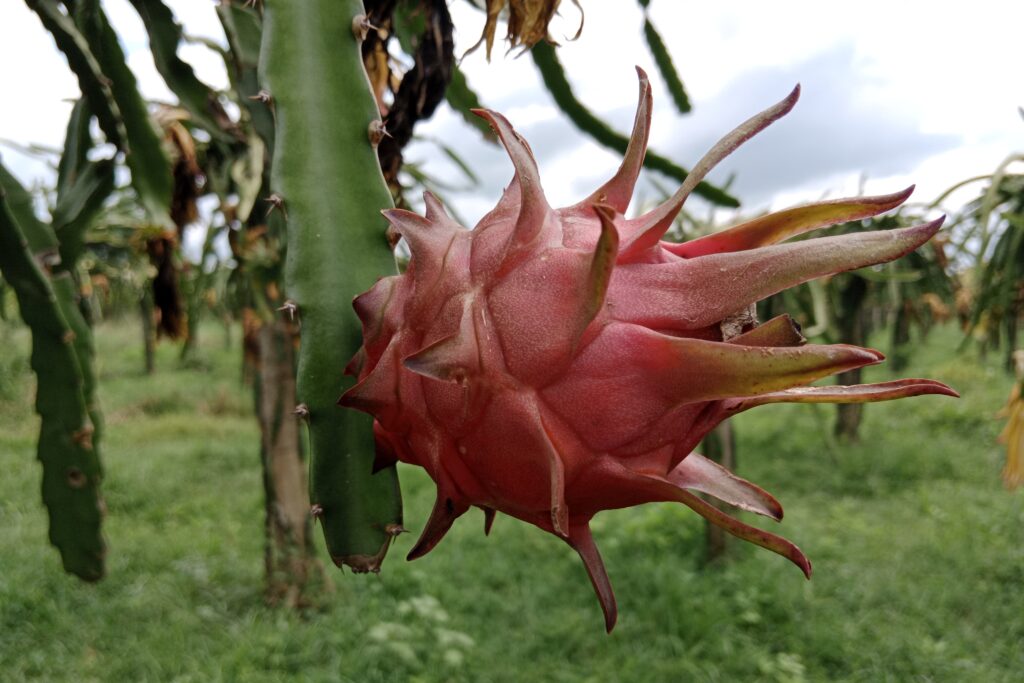Cranberry Farming
Native to North America, the cranberry (Vaccinium macrocarpon) is a perennial, evergreen vine prized for its sour, ruby-red berries that are high in dietary fiber, vitamin C, and antioxidants. Cranberries are gathered fresh for the market or processed into sauces, dried fruit, and juice. They are grown in specific sandy, acidic bogs. With long-lived vines that may yield great quantities for decades with the right care, they are highly valued commercially in temperate regions and are well-known for their unique flavor and health advantages.
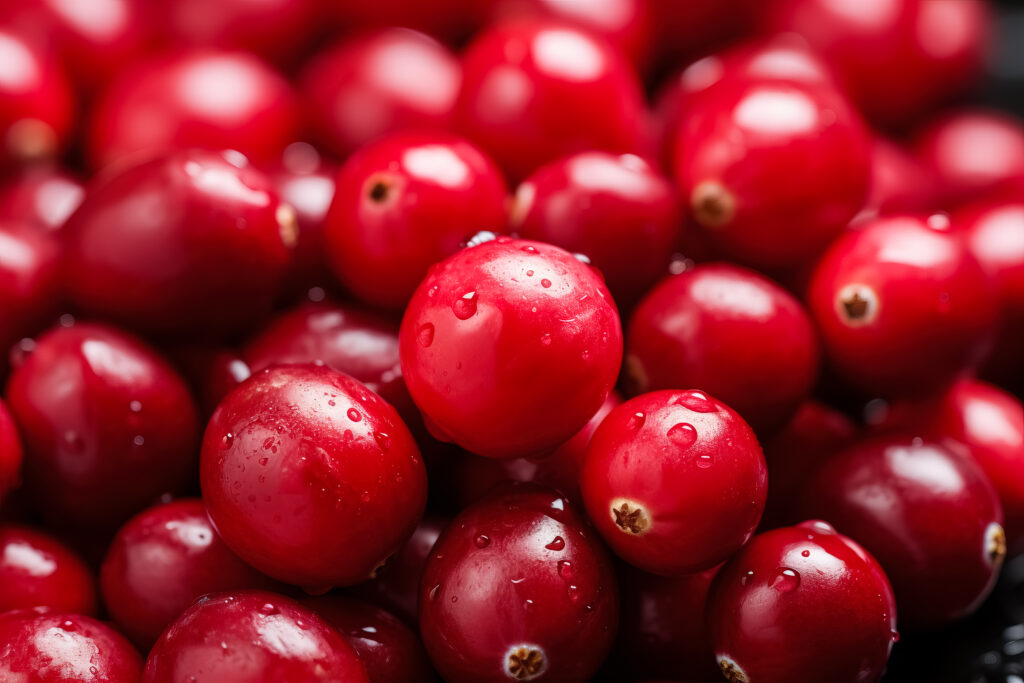
Cranberry farming profit per acre demonstrates exceptional long-term viability, with a 50-year financial projection revealing compelling returns. Despite a substantial initial investment of NRs 1,975,000 per acre for bog establishment, and cumulative annual maintenance costs totaling NRs 12,500,000, the venture generates remarkable lifetime income of NRs 79,432,500.
This translates to a net profit of NRs 64,957,500 per acre, achieving breakeven by Year 7 and delivering peak annualized profits of NRs 1,337,500 during prime production years (7–50). The outstanding 3,290% ROI underscores cranberry farming’s potential as a high-value agro-investment for patient capital in suitable regions.
Land Preparation
Site Selection
Begin by choosing a suitable site for cranberry cultivation. The ideal location should be flat or gently sloping to facilitate water management and avoid erosion. Most importantly, the area must have easy and reliable access to clean water, as cranberries require regular irrigation and periodic flooding for pest control, harvest, and winter protection.
Bog Construction
Constructing the cranberry bog involves several key steps. First, excavate the soil to create shallow beds that are approximately 0.3 to 0.6 meters deep. These shallow basins help in maintaining the necessary water levels for cranberry growth. Next, install essential water management structures such as drainage ditches, dikes, gates, and pumps to regulate water flow, ensure proper drainage, and allow for controlled flooding during different stages of the crop cycle.
Water Retention Measures
To prevent water loss and maintain optimal bog conditions, line the base of the beds with impermeable materials. Common options include clay layers or plastic liners, which help retain moisture within the growing area and minimize seepage into the surrounding soil.
Soil Amendment
Enhance the soil after building a bog by covering the peat or organic soil base with a 5–10 cm layer of coarse sand. In addition to improving drainage, which is essential for root health, this sand layer inhibits weed growth by making it difficult for weed seeds to germinate. Establishing a fruitful cranberry bed requires this step.
Soil Type
Cranberries grow optimally in soils that are distinctly acidic, with a pH range between 4.0 and 5.5, as this environment supports proper nutrient availability and overall plant health. Ideally, the soil should consist of high-organic peat or sandy compositions, which not only encourage robust root development but also provide the right balance between moisture retention and aeration.
These conditions are crucial because cranberries require a root zone that stays evenly moist without becoming waterlogged, ensuring that oxygen can still reach the roots. Water-retentive yet well-aerated soils help maintain consistent growth and fruit production, while heavy clay soils should be strictly avoided, as their poor drainage and compaction can cause water stagnation, restrict root expansion, and ultimately result in weak plants and reduced yields.
Climatic Requirements
Cranberries require a cool temperate climate with 120 to 150 frost-free days during the growing season, ideally with temperatures ranging between 15°C and 25°C. For proper dormancy, winter conditions below 7°C for at least three months are essential, with vines capable of withstanding temperatures as low as −20°C when protected by ice or snow cover. The crop needs an annual rainfall of 1,000 to 2,000 mm, which should be supplemented with irrigation when necessary. Full sunlight exposure of at least six hours per day is also crucial for optimal growth and fruit production.
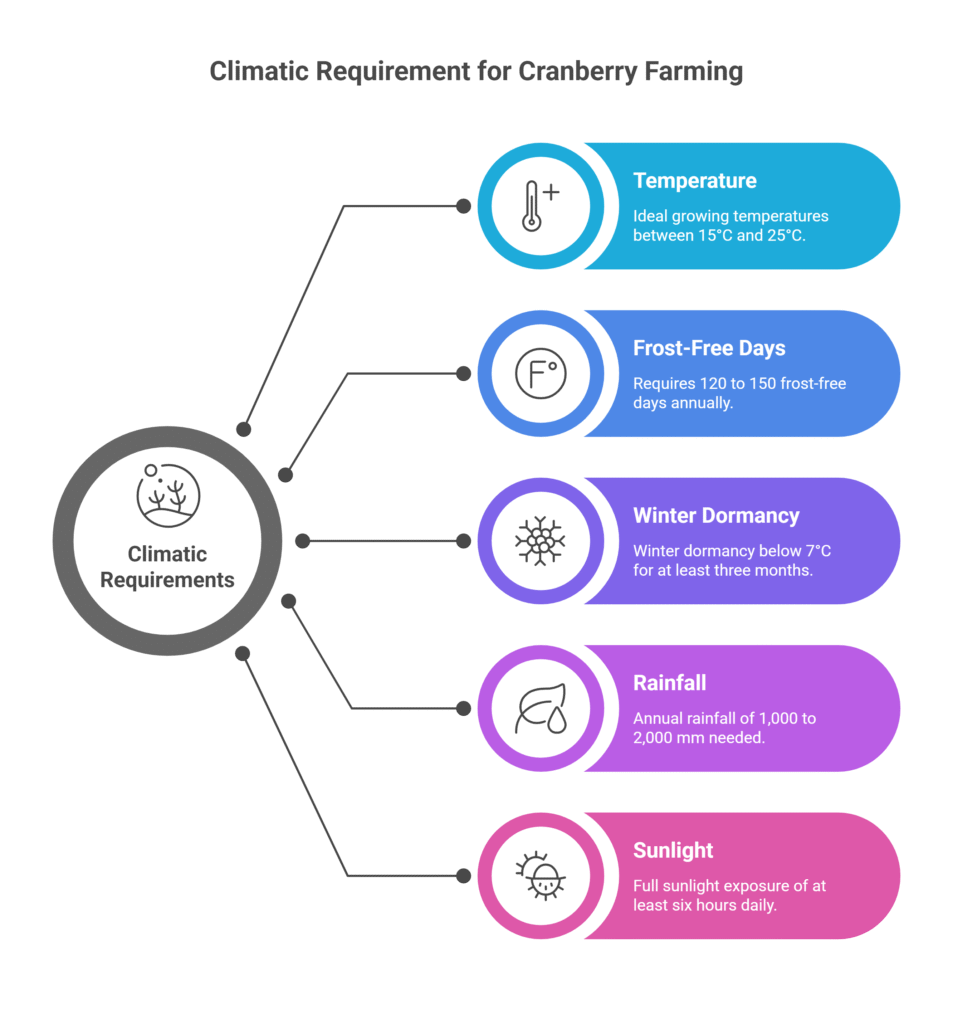
Major Cultivars
| Season | Cultivar | Key Features |
| Early Season | Stevens | Disease-resistant, high-yielding |
| Ben Lear | Preferred for juice production | |
| Mid/Late Season | Pilgrim | Hardy variety, suitable for fresh market |
| Howes | Known for long storage life | |
| New Varieties | Crimson King | Rich in anthocyanins (health-promoting pigments) |
| HyRed | Noted for vibrant fruit color |
Seed Rate per Acre
Cranberries are propagated vegetatively using vine cuttings rather than seeds. For optimal establishment, around 9,000 rooted cuttings per acre are required, each typically 12 to 15 cm in length. These segments should have well-developed roots to ensure healthy growth and quick ground coverage.
Planting
Planting Season
Cranberries are best planted in the spring, usually between April and June, after the risk of frost has passed. This will guarantee that the cuttings will successfully establish and flourish.
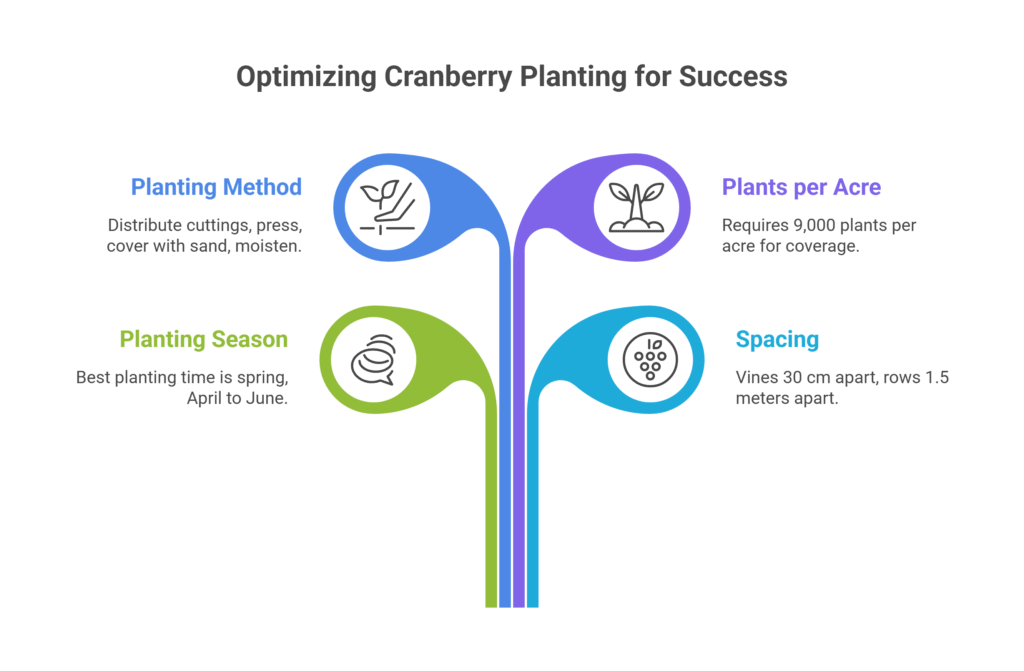
Spacing
Cranberry vines should be planted 30 cm apart within rows to ensure adequate ground coverage and healthy growth. The rows themselves should be spaced 1.5 meters apart to allow for proper air circulation, ease of maintenance, and efficient irrigation or flooding management.
Planting Method
Cranberries are planted by evenly distributing the vine cuttings across the prepared area, gently pressing them into the soil, and then lightly covering them with sand to encourage rooted and control weeds. To help settle the soil around the cuttings and provide adequate soil-to-root contact for effective establishment, the beds should be lightly moistened after planting.
Plants per Acre
Cranberry planting typically requires between 9,000 plants per acre to achieve optimal coverage and yield.
Intercropping
Intercropping with cranberries is rare because of the specialized bog conditions required for their growth. However, during the first one to two years, it is sometimes possible to intercrop low-growing, acid-tolerant plants such as wild blueberries, which can coexist without disrupting the delicate soil and water balance of the cranberry bog.
Irrigation
Irrigation is crucial during key phases of cranberry cultivation, including establishment, flowering in June, and fruit set from July to August. Overhead sprinklers are commonly used not only for regular irrigation but also to provide frost protection during cold spells. Flood irrigation plays a vital role as well, with harvest flooding involving water depths of 30 to 45 cm to float the berries for easier picking, and winter flooding using shallower depths of 15 to 30 cm to insulate the vines and protect them from freezing temperatures.
Fertilizer and Manure
Before applying fertilizers and manure in cranberry cultivation, conducting soil testing is essential to determine nutrient needs accurately. Annually, each acre typically requires 15–20 kg of nitrogen (N), 5–10 kg of phosphorus (P), and 10–15 kg of potassium (K), along with micronutrients like iron and magnesium if deficiencies are identified.
Organic amendments such as composted pine bark, peat moss, or sulfur-coated urea are effective options. Fertilizers should be applied in split doses during spring and early summer, while avoiding nitrogen applications late in the season to prevent excessive vegetative growth and support healthy fruit development.
Weed Control
Effective weed control in cranberry cultivation combines preventive, mechanical, and chemical methods to maintain healthy crop growth. Preventive measures include sand mulching every 2 to 3 years, which helps suppress weed emergence by creating a physical barrier.
Mechanical control involves regular hand-weeding and mowing to physically remove weeds without harming the cranberry plants. Chemical control is used cautiously, with pre-emergent herbicides such as dichlobenil applied at recommended rates of about 2 to 4 kg active ingredient per hectare to prevent weed seed germination, while glyphosate can be used as a spot treatment to target established weeds selectively.
Proper timing and adherence to dosage guidelines are crucial to minimize damage to the cranberry crop and the environment.
Intercultural Operations (Training & Pruning)
Training
Training cranberry plants involves encouraging the horizontal growth of runners to form dense, uniform mats that maximize ground coverage and fruit production. In young beds, it is important to remove upright shoots to promote this spreading habit, ensuring the vines develop a strong, interconnected network for better soil stabilization and yield.
Pruning
There are two primary methods of pruning in cranberry farming to preserve the productivity and health of the vines. Mowing is done in the spring, every two to three years, to revitalize the vines by removing old foliage and promoting the growth of new, robust shoots. This is enhanced by selective pruning, which removes woody or dead growth in certain areas to increase air circulation and light penetration inside the canopy, lower the risk of disease, and boost fruit development.
Flowering and Fruit Management
Flowering
Cranberry plants typically flower in June, marking a critical phase in their reproductive cycle. Successful pollination is essential for fruit production, and bees play a vital role in this process. To ensure effective pollination, it is recommended to maintain 1 to 2 beehives per acre, providing ample pollinator activity during the flowering period.
Fruit Set
During fruit set, maintaining consistent soil moisture is crucial to support the developing berries and prevent stress that could reduce yield. In some cases, growers may use growth regulators such as gibberellins to enhance fruit set and improve berry size, helping to optimize overall production.
Berry Development
As berries mature, they become vulnerable to bird damage, which can significantly impact the harvest. To protect the developing fruit, growers often use physical barriers like nets or deploy scare devices to deter birds and minimize crop losses. These protective measures help ensure a healthy and abundant cranberry yield.
Pest and Disease Management
Common Pests
Fruitworms (Cranberry Fruitworm)
One of the primary pests affecting cranberries is the cranberry fruitworm, which feeds on developing berries, causing significant damage and yield loss. Effective management of this pest often involves the use of insecticides such as Bacillus thuringiensis (Bt), a biological control agent that targets the larvae without harming beneficial insects or the environment. Timely application of Bt during the early larval stages is critical for successful control.
Sparganothis Moth
The Sparganothis moth, whose larvae consume cranberry foliage and can harm the bushes, is another frequent pest. Growers can properly determine population levels and time management efforts by employing pheromone traps, which attract and capture adult moths, to monitor and manage this pest. This approach promotes integrated pest management techniques and lessens the need for extensive chemical applications.
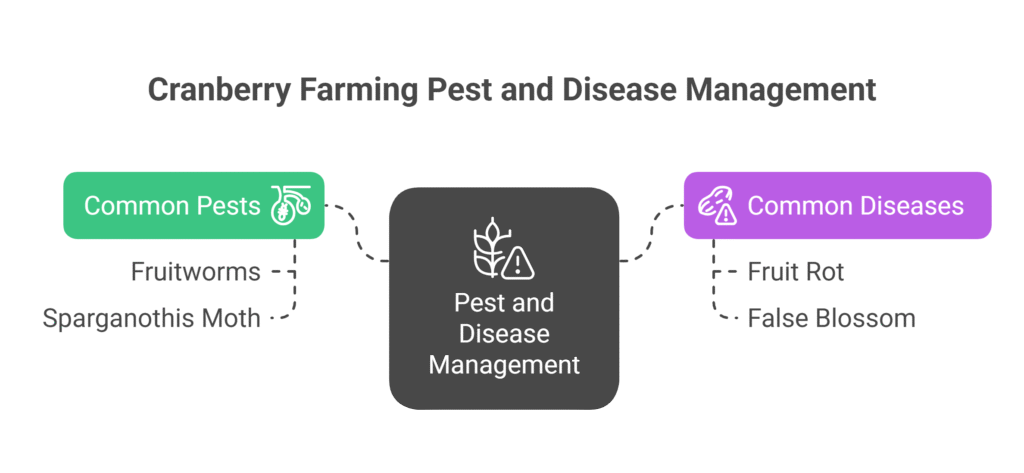
Common Diseases
Fruit Rot (Phytophthora)
Fruit rot caused by Phytophthora species is a serious fungal disease that affects cranberry berries, leading to significant crop losses. Effective management includes the application of fungicides such as fosetyl-Al, which helps control the pathogen. Additionally, maintaining proper drainage in the bog is essential to prevent waterlogging, as excess moisture creates favorable conditions for disease development.
False Blossom (Viral Disease)
False blossom is a viral disease that causes malformation of cranberry flowers and fruit, severely impacting yield. The disease is primarily spread by leafhoppers, so controlling these insect vectors is crucial to managing the disease. Using disease-free planting material and implementing vector control measures can help minimize the incidence and spread of false blossom in cranberry crops.
Harvesting
Timing
When the berries are firm to touch and have become a deep red color, which are signs of complete maturity and ideal flavor, cranberries are usually harvested between September and October.
Methods
Depending on how the berries will be used in the end, there are two primary harvesting techniques. Dry harvesting is perfect for fresh-market sales where fruit quality and presentation are crucial since it uses mechanized pickers to gather berries straight from the plants.
Berries intended for processing are more frequently harvested by wet harvesting, which entails flooding the bogs and using water reels (sometimes called “eggbeaters”) to stir the water and loosen the berries, which float to the top for convenient collecting.
Post-Harvest Handling
After harvesting, the berries are floated, cleaned, and quickly cooled to a temperature of 2–4°C to maintain freshness, reduce spoilage, and preserve quality during storage and transportation. Proper post-harvest handling is essential for extending shelf life and ensuring market readiness.
Yield
Cranberry yields typically range from 4,500 to 9,000 kg per acre, depending on several key factors such as the age of the vines— with peak production usually achieved after five years— as well as the choice of cultivar and overall management practices, including irrigation, fertilization, pest control, and harvesting techniques.
Cost of Investment Per Acre for Cranberry Farming (One-Time Setup Cost)
(Figures in Nepalese Rupees – NRs)
| S.N. | Component | Details | Cost Range (NRs) |
| 1.1 | Land Preparation & Bog Construction | Laser leveling, drainage, sand bedding (4–6-inch layer), dike formation | 700,000 |
| 1.2 | Planting | 9,000 vines (@ NRs 20/vine) + labor | 200,000 |
| 1.3 | Irrigation & Frost Protection | Borewell, pumps, drip, sprinklers, pipelines, frost alarms | 400,000 |
| 1.4 | Equipment & Machinery | Small tractor, sand spreader, harvesting tools, water reels | 600,000 |
| 1.5 | Miscellaneous | Soil testing, permits, pre-planting weed control, consultancy | 75,000 |
| Total Initial Investment | 1975,000 |
Annual Maintenance Cost per Acre for Cranberry Farming
| S.N. | Activity | Details | Cost Range (NRs) |
| 2.1 | Fertilizers & Soil Care | Organic manure, micronutrients, pH balancers, sand top-dressing (biennial) | 60,000 |
| 2.2 | Pest & Weed Management | Fungicides (fruit rot), insecticides (caterpillars), manual weeding | 30,000 |
| 2.3 | Irrigation & Electricity | Water pumping, system maintenance, electricity | 30,000 |
| 2.4 | Labor | Pruning, vine training, pollination support, daily monitoring | 50,000 |
| 2.5 | Harvesting | Manual picking (dry method) or water-reel harvesting (wet method) | 60,000 |
| 2.6 | Repairs & Contingencies | Equipment servicing, frost protection, soil tests | 20,000 |
| Total Annual Cost | 250,000 |
Income from per acre cranberry Farming
| Year | Estimated Yield (Kg/acre) | Market Price (NRs/kg) | Total Income (NRs) |
| 2nd Year | 225 | 300 | 67,500 |
| 3rd Year | 675 | 300 | 202,500 |
| 4th Year | 1,800 | 300 | 540,000 |
| 5th Year | 3,150 | 300 | 945,000 |
| 6th Year | 4,050 | 300 | 1,215,000 |
| 7th–25th Year | 4,500 | 350 | 1,575,000/year |
| 26th–50th Year | 4,000 | 400 | 1,600,000/year |
Analysis of Cranberry Farming Profit Per Acre
| Year/Period | Income (NRs) | Annual Cost (NRs) | Net Profit (NRs) |
| 2nd | 67,500 | 250,000 | -182,500 |
| 3rd | 202,500 | 250,000 | -47,500 |
| 4th | 540,000 | 250,000 | 290,000 |
| 5th | 945,000 | 250,000 | 695,000 |
| 6th | 1,215,000 | 250,000 | 965,000 |
| 7th–25th | 1,575,000 | 250,000 | 1,325,000/year |
| 26th–50th | 1,600,000 | 250,000 | 1,350,000/year |
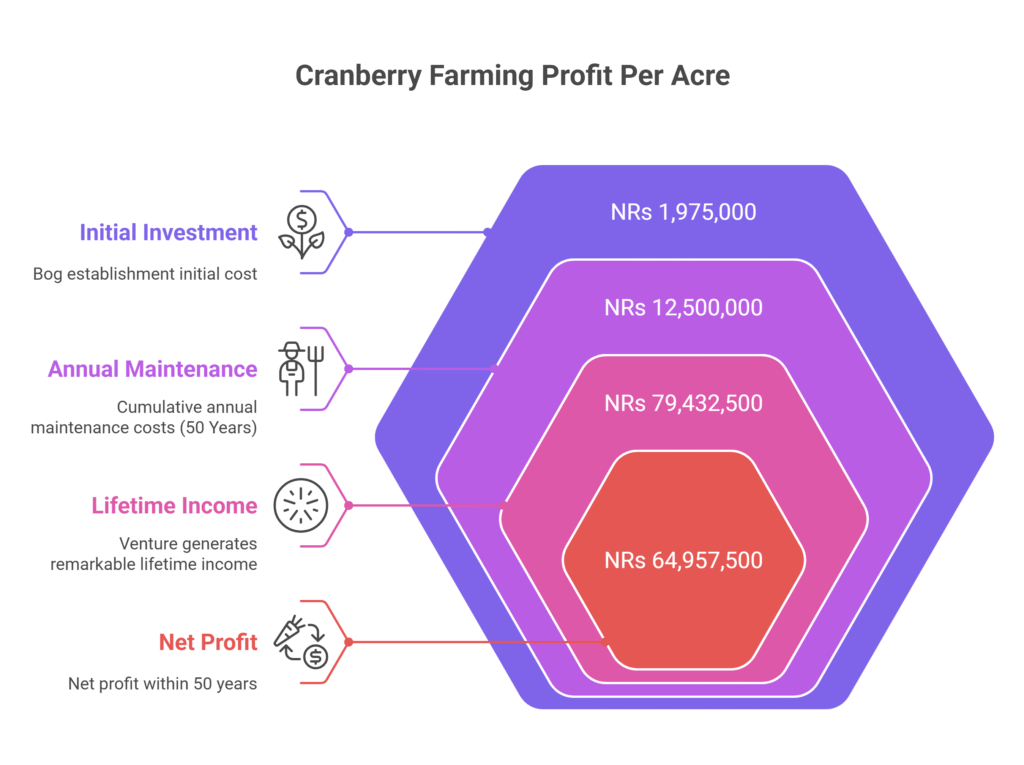
Over a 50-year lifecycle, cranberry farming requires a total initial investment of NRs 1,975,000 for bog establishment, equipment, and planting. Annual maintenance costs of NRs 250,000 accumulate to NRs 12,500,000 over five decades. Projected total income reaches NRs 79,432,500, generating a substantial net profit of NRs 64,957,500 after accounting for all costs. The operation achieves breakeven by Year 7 when cumulative profits turn positive, with peak annual profits averaging NRs 1,337,500 between Years 7–50. This results in an exceptional 3,290% return on investment (ROI) over the 50-year period, demonstrating high long-term viability despite significant upfront costs.
Sources
Oregon State University Extension. Cranberry Production in the Pacific Northwest.
USDA NRCS. Plant Guide: American Cranberry
Indian Council of Agricultural Research (ICAR)

